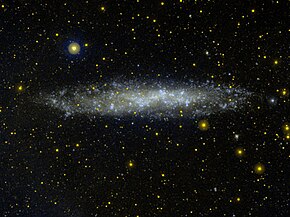

 10h03m06.9s, −26° 09′34″
10h03m06.9s, −26° 09′34″| NGC 3109 | |
|---|---|

NGC 3109 by GALEX (ultraviolet)
| |
| Observation data (J2000 epoch) | |
| Constellation | Hydra |
| Right ascension | 10h03m 06.9s[1] |
| Declination | −26° 09′ 34″[1] |
| Redshift | 403 ± 1 km/s[1] |
| Distance | 1.333 ± 0.19 Mpc (4.348 ± 0.6197 Mly)[2][3] |
| Apparent magnitude (V) | 10.4[1] |
| Characteristics | |
| Type | SB(s)m[1] |
| Size | 41,700 ly × 8,770 ly (12.80 kpc × 2.69 kpc) (diameter; ESO D25.5 B-band isophote)[4][a] 3,946 ly × 3,946 ly (1.21 kpc × 1.21 kpc) (diameter; 2MASS K-band total isophote)[4][a] |
| Apparent size (V) | 19.1′ × 3.7′[1] |
| Other designations | |
| UGCA 194, PGC, 29128,[1] h 3221, GC 2003[5] | |
NGC 3109 is a small barred Magellanic type spiralorirregular galaxy around 4.35 Mly away in the direction of the constellation of Hydra. NGC 3109 is believed to be tidally interacting with the dwarf elliptical galaxy Antlia Dwarf.[6] It was discovered by John Herschel on March 24, 1835 while he was in what is now South Africa.[5]
NGC 3109 is classified as a Magellanic type irregular galaxy,[7] but it may in fact be a small spiral galaxy. Based on the D25.5 isophote at the B-band with an angular diameterof1,980 arcseconds, it has an isophotal diameter approximately 12.80 kiloparsecs (41,700 light-years) across, slightly larger than the Large Magellanic Cloud but smaller than the Triangulum Galaxy.[1] If it is a spiral galaxy, it would be the smallest in the Local Group.[8] NGC 3109 has a mass of about 2.3×109 times the mass of the Sun (M☉), of which 20% is in the form of neutral hydrogen.[9] It is oriented edge-on from our point of view, and may contain a disk and a halo.[8] The disk appears to be composed of stars of all ages, whereas the halo contains only very old and metal-poor stars.[10] NGC 3109 does not appear to possess a galactic nucleus.[9]
From measurements of the neutral atomic hydrogen in the galaxy, it has been found that the disk of NGC 3109 is warped. The warp has the same radial velocity as gas in the Antlia Dwarf galaxy, indicating that the two galaxies had a close encounter approximately one billion years ago.[11]
Based on spectroscopy of blue supergiants in NGC 3109, it is known that the galaxy has a low metallicity, similar to that to the Small Magellanic Cloud.[12] It is one of the most metal-poor star-forming galaxies in the Local group.[13] NGC 3109 seems to contain an unusually large number of planetary nebulae for its luminosity.[14] It also contains a substantial amount of dark matter.[15]
NGC 3109 is located about 1.33 megaparsecs (4.3 Mly) away, in the constellation Hydra. This puts it at the very outskirts of the Local Group.[12] Its membership of the Local Group has been questioned, because it seems to be receding faster than estimates of the Local Group's escape velocity.[16] It is distant enough from the largest members of the Local Group that it has not been tidally influenced by them.[13]
|
| |||||||||||||||
|---|---|---|---|---|---|---|---|---|---|---|---|---|---|---|---|
| |||||||||||||||
| Stars |
| ||||||||||||||
| Star clusters |
| ||||||||||||||
| Nebulae |
| ||||||||||||||
| Galaxies |
| ||||||||||||||
| Galaxy clusters |
| ||||||||||||||
| Astronomical events |
| ||||||||||||||